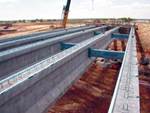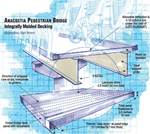Structural makeover: Big bridge-strengthening project
The 2.5-km/1.6-mile long cable-stayed-concrete West Gate Bridge in Melbourne, Australia, is prepped for added traffic lanes with BASF's MBrace composite reinforcements, pultruded by EPSILON Composite (Gaillan-en-Médoc, France).
In what is reportedly the largest bridge-rehabilitation project ever undertaken with composites, the 2.5-km/1.6-mile long cable-stayed-concrete West Gate Bridge, the third largest in Australia, is getting a makeover. The bridge’s central, three-cell box girder rises 58m/190 ft above the Yarra River in Melbourne, Victoria, with attached precast cantilevered frame elements that support the roadway. A tremendous increase in traffic since the bridge opened in 1978 — it now accommodates 160,000 vehicles per day — prompted the Roads Corp. of Victoria (VicRoads), the state’s highway authority, to commission a study 10 years ago to determine the best way to address the increased design loads if traffic lanes were added. The selected concept combined post-tensioned tendons in the box girder with precured carbon fiber-reinforced polymer (CFRP) laminates. Despite higher material costs, compared to a steel plate solution, this alternative promised ease of installation, lack of traffic disruption and virtually no long-term maintenance costs.
Granted $240 million (AUS) in state and federal funds, the West Gate Bridge Strengthening Alliance — VicRoads; construction firm John Holland and design/engineering firm Sinclair Knight Merz (both of Melbourne); and designer Flint and Neill Partnership (London, U.K.) — started work on the bridge’s east end in October 2009. Crews applied Melbourne-based BASF Corporation - Building Systems trademarked MBrace uni carbon laminates, pultruded by EPSILON Composite (Gaillan-en-Médoc, France), and carbon fabrics wet out with BASF epoxy around the box girder’s perimeter. To increase the deck slab’s flexural capacity between the cantilever frames, CFRP strips were inserted into slots cut into the deck. Other key areas (e.g., where the frames attach to the box girder) also were strengthened, say Rob Irwin and Amar Rahman of BBR Systems Ltd. (Zurich, Switzerland), who provided early design/technical support. More than 100 km/62 miles of carbon plates, 10,000m² (107,670 ft²) of carbon fabric, 65 metric tonnes (143,300 lb) of adhesive and 20 metric tonnes (44,100 lb) of epoxy resin will be used before the project ends in 2011. BASF business manager Andrew Sarkady says, “With the Alliance, we were able to find a smart solution, which led to significant savings, based on reduced labor alone.”
Related Content
-
JEC World 2024 highlights: Thermoplastic composites, CMC and novel processes
CW senior technical editor Ginger Gardiner discusses some of the developments and demonstrators shown at the industry’s largest composites exhibition and conference.
-
Plant tour: Collins Aerospace, Riverside, Calif., U.S. and Almere, Netherlands
Composite Tier 1’s long history, acquisition of stamped parts pioneer Dutch Thermoplastic Components, advances roadmap for growth in thermoplastic composite parts.
-
Low-cost, efficient CFRP anisogrid lattice structures
CIRA uses patented parallel winding, dry fiber, silicone tooling and resin infusion to cut labor for lightweight, heavily loaded space applications.



